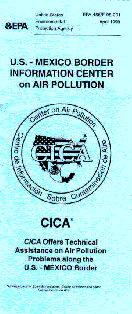|
 |
 |
Versión en
Español
About CICA
U.S. - MEXICO
BORDER INFORMATION CENTER on AIR POLLUTION
(CICA)*
* The acronym CICA derives from the Center's name in Spanish: Centro
de Información sobre Contaminación de Aire

CICA GOAL
CICA provides technical support and assistance in evaluating
air pollution problems along the México -
U. S. Border. These services and products are available at no cost
to Federal, State and Local Agencies and Universities in México.
Others can use these services depending on available resources. CICA is
sponsored by EPA's CLEAN AIR TECHNOLOGY CENTER (CATC).
A wide range of technical assistance is offered on:
- Air pollutants and control strategies
- Pollution prevention and control technology applications
- Operation and maintenance problems
- Emission inventory
- Emission factors
- Dispersion modeling
- Ambient monitoring
- Emission measurement
- Risk analysis
CICA provides ready access to EPA information and expertise. It draws on
professional staff from the Office of Air Quality Planning and Standards
(OAQPS). Private contractors
also are available when appropriate.
CICA SERVICES
The CICA provides assistance in the following ways:
LINES OF COMMUNICATION
CICA's lines of communication provide rapid responses to questions based
on available information from the U.S. EPA and its contractors. Questions
are directed to EPA's most knowledgeable experts on the topic. In addition,
CICA's Internet World Wide Web home page offers
the following for the U.S. - México Border area:
ENGINEERING ASSISTANCE/TECHNICAL GUIDANCE
Where more in-depth environmental engineering assistance such as an
engineering analysis or technical guidance may be needed, the EPA and
its contractors can provide assistance on a range of topics, including:
- Evaluation of source emissions
- Identification of control alternatives
- Estimates of control costs
- Advice on permit conditions to assure good operation and maintenance
of control equipment.
GUIDANCE DOCUMENTS AND SOFTWARE TOOLS
Provides access to control technology guidance and information transfer,
including:
- Alternative control technology documents for specific types of air
pollution sources
- Personal computer software programs to assess emissions control problems
and potential solutions.
INTERNATIONAL TECHNOLOGY TRANSFER CENTER FOR GLOBAL GREEN HOUSE GASES
The International Technology Transfer Center for Global Greenhouse Gases
provides technology transfer regarding greenhouse gas emissions. This
assistance includes characterizations of global emissions from anthropogenic
sources and available prevention, mitigation, and control technologies/strategies
for major sources of greenhouse gases. Information is available for methane
emissions from landfills and other waste management facilities, the natural
gas industry, and coal mining. In addition, information is available on
biomass use for energy generation and production of liquid fuel, and for
pollution prevention technologies.
ON-LINE ASSISTANCE
- CICA Web (English/Spanish)
- CICA Web provides access to CICA products and bilingual information
on pollution prevention and control technology applications for
the U.S.-México Border
- CATC Web (English)
- CATC Web serves as a resource on all areas of emerging and existing
air pollution prevention and control technologies, and provides
public access to data and information on their use, effectiveness
and cost. CATC Web allows you to access:
The
RBLC provides data on prevention and control technology determinations
made by State and local permitting agencies. The Clearinghouse
contains over 3,500 determinations that can help you identify
appropriate technologies to mitigate most air pollutant emission
streams. The RBLC was designed to help permit applicants and reviewers
make pollution prevention and control technology decisions for
stationary air pollution sources and includes data submitted by
50 States and territories in the U.S. on over 200 different air
pollutants and 1,000 industrial processes.
The Clearinghouse also has a regulation data base that summarizes
all emission standards and control technique guidelines (CTG)
issued by EPA's Office of Air Quality Planning and Standards (OAQPS).
This includes new source performance standards (NSPS), national
emission standards for hazardous air pollutants (NESHAP), and
maximum achievable control technology (MACT) standards. The regulation
data base also includes prevention and control technology cost
information related to each rule and references to supporting
documentation.
* NOTE: Are you wondering what "RACT, BACT and LAER" stand for and
why these acronyms are part of the Clearinghouse name? Well, they
are acronyms for different program requirements required under the
Clean Air Act which also gave us the name "RACT/BACT/ LAER Clearinghouse."
RACT, or Reasonably Available Control Technology, is required on existing
sources in areas that are not meeting national ambient air quality
standards (i.e.,nonattainment areas). BACT, or Best Available Control
Technology is required on major new or modified sources in clean areas
(i.e., attainment areas). LAER, or Lowest Achievable Emission Rate,
is required on major new or modified sources in nonattainment areas.
However, data in the Clearinghouse is not limited just to sources
subject to these requirements. Noteworthy prevention and control technology
decisions are included in the RBLC even if they are not related to
RACT, BACT, or LAER decisions.
TTN Web (English)
Postal correspondence - Send correpondence to:
U.S.-México Information Center on Air Pollution/Centro
de Información sobre Contaminación de Aire (CICA)
Attention: CATC (MD-12)
U. S. Environmental Protection Agency
Research Triangle Park, NC 27711 USA
Telephone/Fax (English/Spanish)
- Toll-Free telephone assistance from México only: (800) 304-1115
- Telephone assistance from other locations: (919) 541-1800
- FAX assistance: (919) 541- 0242
E-mail
CICA Web
|


